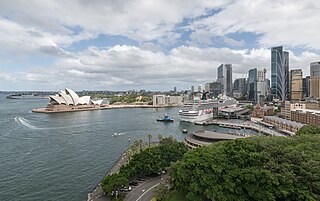
Circular Quay is a harbour, former working port and now international passenger shipping terminal, public piazza and tourism precinct, heritage area, and transport node located in Sydney, New South Wales, Australia on the northern edge of the Sydney central business district on Sydney Cove, between Bennelong Point and The Rocks. It is part of the local government area of the City of Sydney.

Central Park is a 51-storey office tower in Perth, Western Australia. The building measures 226 m (741 ft) from its base at St Georges Terrace to the roof, and 249 m (817 ft) to the tip of its communications mast. Upon its completion in 1992, the tower became the tallest building in Perth, and was the 4th tallest in Australia from then till 2005. It is also currently the sixteenth tallest building in Australia and the tallest building in the western half of Australia.

Nauru House is a landmark 52-storey building located in the Melbourne central business district, Victoria, Australia. The building was designed by architectural firm Perrott Lyon Timlock & Kesa and completed in 1977.

Australia Square Tower is an office and retail complex in the central business district of Sydney. Its main address is 264 George Street, and the Square is bounded on the northern side by Bond Street, eastern side by Pitt Street and southern side by Curtin Place.

Chifley Tower is a skyscraper in Sydney, Australia. It was designed by New York City-based architects Travis McEwen and Kohn Pedersen Fox, with John Rayner as project architect. At a height of 244 metres, Chifley Tower was the tallest building in Sydney from 1992 to 2019. It was surpassed in height by Crown Sydney in 2020 along with the Salesforce Tower and One Sydney Harbour in 2022.
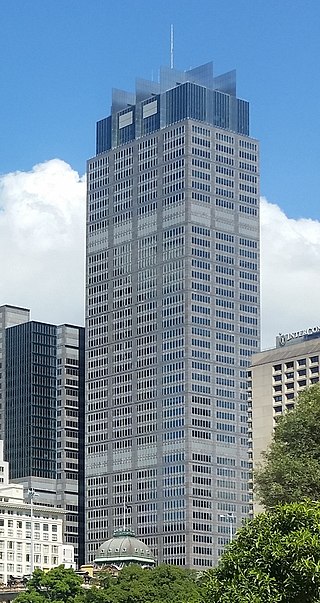
The Governor Phillip Tower, the Governor Macquarie Tower, and the Museum of Sydney are the main elements of a large development in the central business district of Sydney, New South Wales, Australia. Completed in 1994, the property development complex occupies an elevated site in the north-east area of the central business district. The complex incorporates the site of the first Government House, one of Australia's earliest and most significant sites of European heritage. The address is 1 Farrer Place, Sydney. Designed by architects Denton Corker Marshall and built by Australia's largest privately owned construction company Grocon, at the time of its completion it was regarded as achieving new standards for Sydney commercial architecture in terms of finish quality and design.
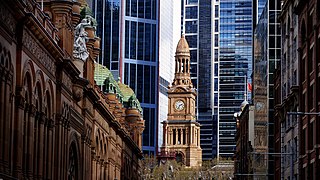
The architecture of Sydney, Australia’s oldest city, is not characterised by any one architectural style, but by an extensive juxtaposition of old and new architecture over the city's 200-year history, from its modest beginnings with local materials and lack of international funding to its present-day modernity with an expansive skyline of high rises and skyscrapers, dotted at street level with remnants of a Victorian era of prosperity.

PTW Architects is an Australian architecture firm founded in Sydney in 1889. In 2013, PTW was acquired by the Chinese architecture and engineering consulting firm China Construction Design International (CCDI).

3XN is a Danish architectural practice headquartered in Copenhagen and with offices in Stockholm, London, New York and Sydney.

1 Bligh Street is a skyscraper in Sydney, New South Wales, Australia.
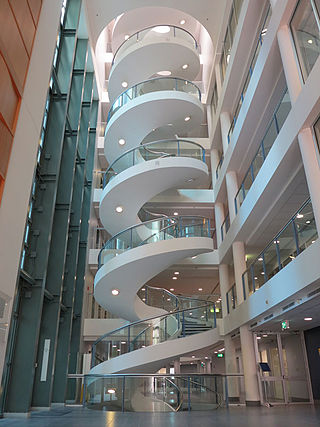
Kenneth Frank Charles Woolley, BArch, Hon DSc Arch Sydney LFRAIA, FTSE, was an Australian architect. In a career spanning 60 years, he is best known for his contributions to project housing with Pettit and Sevitt, four time Wilkinson Award-winning architect, including three times for his own house, the first being the 1962 Woolley House in Mosman, and his longstanding partnership with Sydney Ancher and Bryce Mortlock. He is regarded as being a prominent figure in the development of the Sydney School movement and Australian vernacular building.

6 & 8 Parramatta Square is a skyscraper in Parramatta, New South Wales, Australia, a centrepiece of the Parramatta Square development. The building consists entirely of commercial office space, making up 120,000 square metres (1,300,000 sq ft) of floorspace, at a height of 225.45 metres (739.7 ft), making it the tallest building in Parramatta and outside the Sydney central business district. It was built in the Parramatta Square Development on plot 8 called PSQ8.
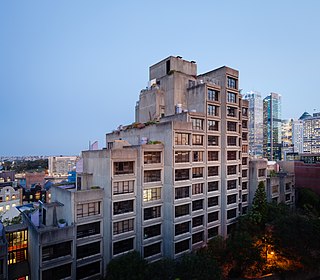
The Sirius building is an apartment complex in The Rocks district of Sydney, New South Wales, Australia. Designed for the Housing Commission of New South Wales in 1978–1979 by commission architect Tao Gofers, the building is a prominent example of Brutalist architecture in Australia. It also has striking repetitive geometries in reaction to the Japanese metabolist architecture movement. Notable for being the only high rise development in The Rocks, Sirius housed 79 apartments with one, two, three or four bedrooms, generally with single storey apartments to two and three storey walk ups. The complex was built to rehouse displaced public tenants after a controversial redevelopment of the Rocks during the 1960s and 70s.
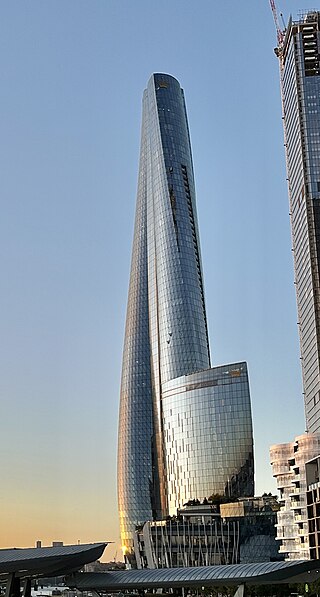
Crown Sydney is a skyscraper in Barangaroo, New South Wales, Australia. Designed by WilkinsonEyre, it stands at a height of 271.3 m (890 ft) with 89 floors, making it the tallest building in Sydney and 4th tallest building in Australia. It was developed by Crown Resorts, primarily comprising a hotel and residential apartments, while a casino and other hospitality venues make up the rest of its floorspace. Construction first began in October 2016, before topping out in March 2020. The tower was inaugurated to the public in December 2020.

1 Macquarie Place is a skyscraper in the Sydney central business district, located on Macquarie Place.

The Overseas Passenger Terminal (OPT), known officially as the Sydney Cove Passenger Terminal, is a public passenger terminal servicing cruise ships and ocean liners located in Circular Quay, Sydney, Australia. Whilst commercial shipping operations on and around the site date from 1792, the current primary structure and waterfront promenade date from 1958, with subsequent on-going alterations and land reclamation throughout the latter part of the 20th century. The current design retains the black steel portal frame trusses of the original 1958 structure, with major additions completed in 1988 in the Post-War International Style through the collaboration of Sydney architects Lawrence Nield and Peter Tonkin.

Gold Fields House was a high rise office block in the Sydney central business district on the corner of Alfred and Pitt streets. Completed in 1966, it was one of the earliest high rise buildings in Sydney. The tower of 27 storeys was designed by Peddle, Thorp and Walker "as a balance to the AMP Building" constructed four years earlier in 1962 at the other end of Circular Quay. Together they created a "gateway" to the city of Sydney. It was sold for redevelopment in 2014 and demolished in 2017/2018.

The MLC Building is a landmark modernist skyscraper in the central business district of North Sydney, on a block bounded by Miller Street, Denison Street and Mount Street. Planned in 1954 and completed in 1957, the complex was designed in the modernist Post-war International style by architects, Bates, Smart & McCutcheon. Its completion marked the appearance of the first high-rise office block in North Sydney and the first use of curtain wall design. Built to provide much-needed office space for the Mutual Life & Citizens Assurance Company Limited, the building continues to be primarily-occupied by its original tenants. It was added to the New South Wales State Heritage Register on 2 January 2024.

Hinchcliff House is a heritage-listed former wool store, hostel for homeless men and university campus at 5–7 Young Street, Sydney, City of Sydney, New South Wales, Australia. The southern section was built c. 1860, while the northern section was built in the 1880s. It is also known as Hinchcliff's Woolstore, Ozanam House and EF House. It was added to the New South Wales State Heritage Register on 2 April 1999.


























